April 16, 2025

Clarity for Professional Services Automation
Why Purpose-Built PSA Tools Won’t Cut It
6 min read

Written by: Stefania D'Alessandro
|
Key Takeaways
|
|
Professional services automation (PSA) tools are meant to streamline service delivery, manage resources, and improve profitability. However, many purpose-built PSA tools fall short when it comes to strong financial and resource management, extensibility, integration, and the ability to manage both strategic and operational processes effectively. These areas are where Clarity stands out.
Clarity is designed to provide organizations with a comprehensive, unified view of opportunities, resources, and financials. The solution ensures that professional services organizations (PSOs) can deliver on client engagements predictably and profitably, all while staying agile in a constantly evolving environment.
PSA vs. PPM: Understanding the critical differences
It’s important to recognize that PSA and project portfolio management (PPM) are distinct but complementary concepts. Here’s more information on each:
- PSA is client-focused, revenue-driven, and service delivery-oriented. PSA places a strong emphasis on managing external client relationships, ensuring client satisfaction, and boosting profitability. It begins with a sales-driven intake process, capturing client projects and service requests. PSA is designed to optimize service delivery while enhancing the client experience.
- PPM, on the other hand, is internally focused, governance driven, and project execution oriented. PPM revolves around managing the entire project lifecycle, ensuring alignment with strategic business goals, and optimizing resource utilization across the organization. The intake process in PPM is centered on aligning projects with strategic objectives, ensuring that initiatives directly support the organization’s overarching goals.
While both PSA and PPM involve elements of project management and resource allocation, the key difference lies in their core focus: PSA is about delivering services to clients efficiently and ensuring their satisfaction, while PPM focuses on managing internal projects and aligning them with broader organizational strategy.
Common PSA challenges
Many organizations face several challenges when it comes to their PSA solutions:
- Legacy system replacements. Older solutions are being phased out, while some alternatives lack robust operational project management capabilities.
- Lack of pipeline visibility. Many organizations lack a formalized process to forecast opportunities, resulting in reactive planning and an inability to proactively manage the orders-to-cash process.
- Suboptimal resource utilization. Misalignment between resource skills, capacity, and project demand leads to understaffing, high bench rates, or overloaded teams, which has a negative impact on service quality, delivery timelines, and customer satisfaction. The absence of real-time insights hinders effective planning.
- Poor engagement management. Without proper tools to track engagement performance, organizations struggle to manage projects effectively, lacking data-driven insights to ensure timely and successful service delivery.
- Burdensome time tracking. Complex and burdensome timesheet entry leads to inaccurate or inconsistent time reporting, resulting in billing delays and operational inefficiencies.
- Audit, compliance, and revenue recognition risks. The absence of a clear linkage between revenue recognition and service delivery can lead to financial penalties.
- Poor data governance. Organizations rely on disparate systems (CRM, PSA, ERP) to manage resources, schedules, engagements, and timesheets. This leads to inefficiencies, manual reconciliations, outdated reporting, and unreliable data, limiting leadership's ability to gain real-time operational insights and make informed decisions.
How Clarity empowers PSA
Clarity solves these challenges by providing a single-pane-of-glass view of professional services delivery, ensuring better control, visibility, and efficiency across the entire process.
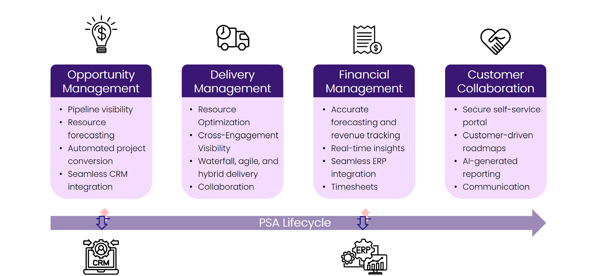
1. Opportunity management
- Pipeline visibility: Gain clear insights into opportunities and forecast demand.
- Automated project conversion: Simplify project creation by automating conversion from opportunity to project.
- Proactive resource forecasting: Plan capacity in advance and prevent resource bottlenecks.
- Seamless CRM integration: Gain a unified view of customer relationships and opportunities.
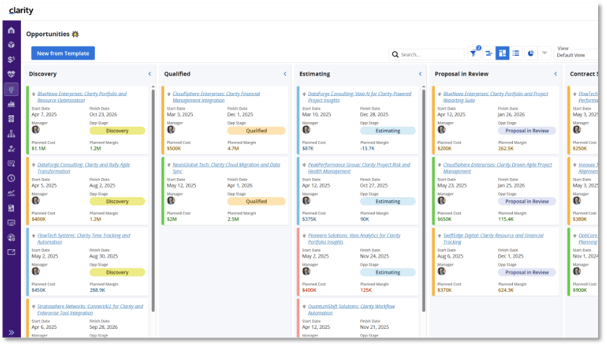
Opportunity lifecycle: From discovery to contract signed
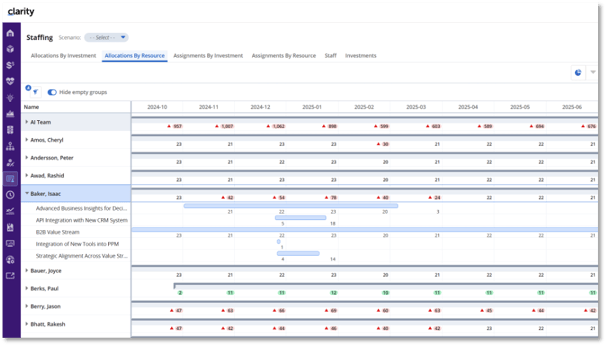
Proactive resource forecasting and bottleneck analysis
2. Delivery management
- Resource optimization: Allocate the right talent to the right projects based on skills and availability.
- Flexible delivery models: Gain support for waterfall, agile, or hybrid project methodologies.
- Cross-engagement visibility: Track financials, billing milestones, and risks in real time.
- Integrated collaboration: Share documents and track conversations in one centralized platform.
- Proactive risk management: Identify potential project risks early and take corrective actions.
- Audit and traceability: Maintain baselines and audit logs for accurate monitoring.
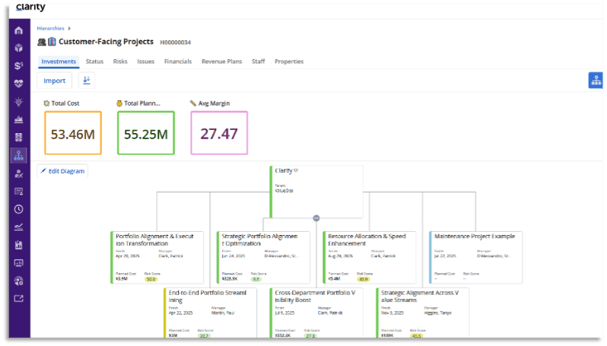
Overview of engagements per product
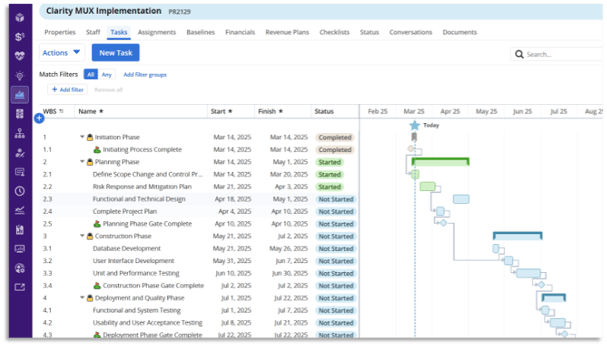
Services delivery WBS
3. Financial management
- Integrated financial and resource management: Ensure accurate labor cost calculations and profitability analysis.
- Real-time financial insights: Track margins, revenue, and costs in real time.
- Seamless ERP integration: Automate invoicing and financial workflows for smoother operations.
- Mobile-friendly timesheets: Capture and approve billable hours efficiently.
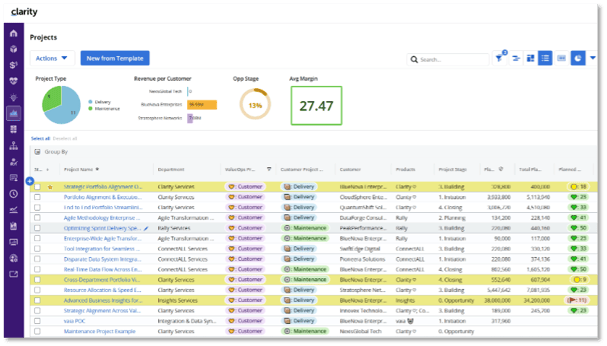
Engagements: Financial performance and margin analysis
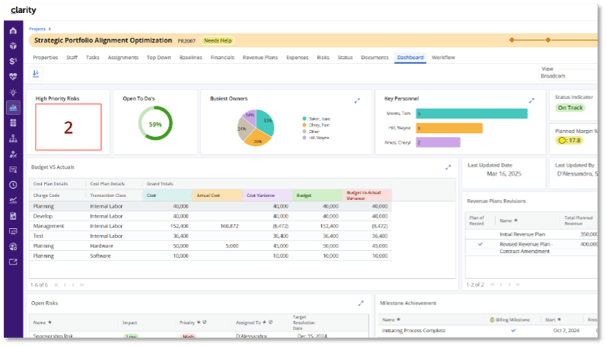
Engagement financial dashboard
4. Customer collaboration
- Secure self-service portal: Provide customers with real-time access to project details and reports.
- Customer-driven roadmaps: Track feature requests, backlog status, and roadmap progress transparently.
- AI-generated insights: Leverage AI to automate status reports and key updates for customers.
- Integrated communication: Keep customers informed with integrated notifications and shared updates.
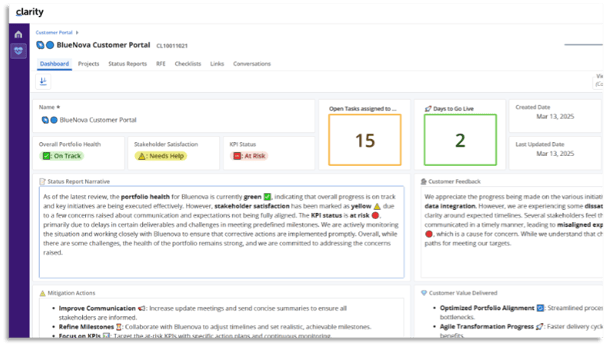
Customer portal: Dashboard
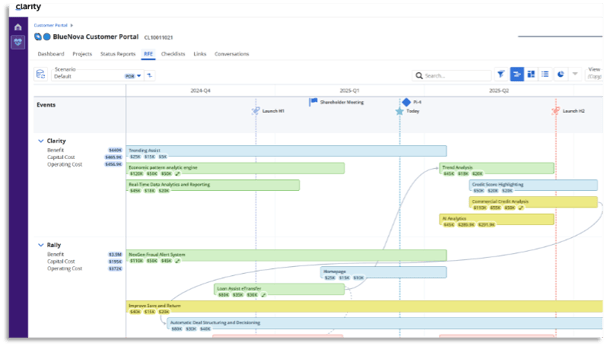
Customer portal: Request for enhancements roadmap
Other key benefits of Clarity
- Modern UX: Intuitive, easy-to-use interface for improved user adoption and productivity.
- Productivity and automation: Boost efficiency with templates, workflows, and automation tools.
- Enterprise-wide visibility: Manage both customer-facing and internal projects in one system.
- Seamless integrations: Effortlessly integrate with other systems via REST APIs and ValueOps ConnectALL.
Transform your PSA practice with Clarity
Clarity isn’t just another PSA tool; Clarity is widely used by leading companies globally to automate professional services, streamlining and enhancing operations. Clarity supports businesses of various sizes and sectors, including healthcare organizations delivering customer projects and tracking KPIs, telecom providers managing the entire client lifecycle from lead to cash, and industrial firms optimizing resource allocation and operational analysis. With user populations ranging from a few hundred to several thousand, Clarity adapts to the unique needs of diverse organizations, enabling improved services, optimized operations, enhanced decision-making, and reduced operational costs.
Get started with Clarity today
Ready to streamline your PSA practice? Discover how Clarity can help optimize your operations and drive success.

Stefania D'Alessandro
Stefania D'Alessandro specializes in aligning enterprise objectives with ValueOps capabilities to deliver measurable value to customers.
Other resources you might be interested in
Top 3 Trends Defining Network Observability in 2026
Discover the three specific trends that will define network observability in 2026. See how unified observability and predictive AI will shape the landscape.
Rally Office Hours: December 18, 2025
Rally Office Hours features an AI-driven artifact breakdown tool that creates child items from features/stories. The Q&A covers capacity planning, forecasting and burnup charts.
Why 2025 Shattered the Old Rules of Network Management
This post reveals the five key lessons network operations leaders learned in 2025—and how they need to respond to be successful in 2026.
The 2026 VMUG Report: Why Network Observability is the Heart of the New VCF Era
Get the top takeaways from the VMUG Cloud Operations and VCF User Experience Report 2026. See why network observability is key to successful VCF 9 migrations.
Automic Automation Cloud Integration: SAP S/4 HANA Application Jobs Integration
Simplify your SAP S/4HANA job management. Integrate with Automic Automation for central configuration, monitoring, and orchestration of all your enterprise jobs.
Automic Automation Cloud Integration: OpenSSH Integration
Master Open SSH automation. Use Automic Automation for centralized control, secure file transfer, command execution, and full job monitoring.
Rally Office Hours: December 11, 2025
Discover Rally's new Ancestors field, static query box deprecation, non-conflicting saves, plus a dashboard demo and query writing tips.
3 Questions I Expect You to Ask Me
Ask these questions to gain a deeper understanding of a vendor. Find a partner who can solve today’s challenges and prepare you for what’s next.
Carrier-Grade Network Observability: A Technology Brief for Telco Network Operations
Network Observability by Broadcom unifies data to provide contextual, AI-enabled insights for superior service availability, accelerated MTTR and improved MTTI, reduced operational costs, and the...
